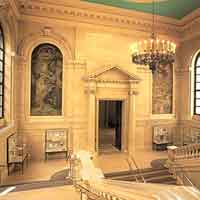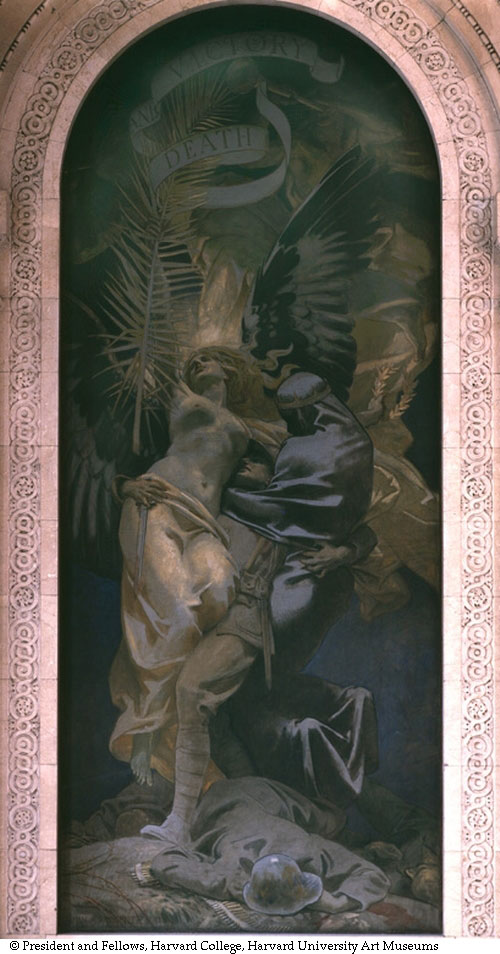Death
and Victory
John Singer
Sargent -- American
painter
1922
Widener
Library, Harvard
University
Oil on canvas
439.42 x
186.69 cm (173
x 73.5 in)
Anonymous gift
to Harvard
University - L109
jpg: Sargent
at Harvard
Step Back

Stairwell
at Widener

Widener
Library
Notes
Bibliography:
Margaret E. Gilman,
"The Sargent
Panels in the Widener Library", Harvard Graduates' Magazine, Dec. 1922,
pp. 215-216
Harvard Crimson,
Dec. 4, 1928
John Walker III,
"To the Editor of
the Crimson", Harvard Crimson, June 7, 1929
"Sargent Murals
Well Received at
First Appearance", Harvard Crimson, June 8, 1929, p. 1
"Mural Paintings
and Sargents at
Widener", Boston Evening Transcript, March 9, 1929
"The Writing on the
Wall", Harvard
Crimson, May 31, 1929
"Unveil Sargent's
Paenls at Harvard",
American Art News, Nov. 11, 1922, p. 5
"Harvard's Heroic
War Dead Immortalized
by John Singer Sargent", Boston Evening Transcript, Nov. 3, 1922, p. 20
F.W. Coburn, "In
the World of Art",
The Sunday Herald, Boston, Nov. 5, 1922
Forum
From: Ali Mooraj
ag moo
raj@blueyonder.co.uk
Date: Fri, 5 Mar
2004
Dear Natasha
Are you aware of
the reference
to this painting in Steven Pinker: "The Blank Slate", Penguin Books
2002,
p.160 ?
(Pinker is a
Harvard Psychologist)
I have not studied
your full gallery
site in detail and am not sure whether you are also collecting
interpretations
or critiques of Sargent's work. The book by Steven Pinker discusses the
current state of the nature-nurture debate on inheritance. He is also
the
author of "The Language Instinct" and "How the mind works".
Pinker's context is:
As
with the other convictions surrounding the Blank Slate,[1]
the fear of imperfectability makes some sense in the context of
twentieth-century
history. A revulsion to the idea that people are naturally bellicose or
xenophobic is an understandable reaction to an ideology that glorified
war. One of the most memorable images I came across as a graduate
student
was a painting of a dead soldier in a muddy field. A uniformed ghost
floated
up from his corpse, one arm around a cloaked and faceless man, the
other
around a bare-breasted blond Valkyrie. The caption read, "Happy those
who
with a glowing faith in one embrace clasped death and victory." Was it
a kitschy poster recruiting cannon fodder for an imperial
exploit?
A jingoistic monument in the castle of a Prussian military aristocrat?
No, Death and Victory was painted in 1922 by the great American artist
John Singer Sargent and hangs prominently in one of the world's most
famous
scholarly libraries, the Widener at Harvard University.
That
a piece of pro-death iconography should decorate these hallowed halls
of
learning is a testament to the warmongering mentality of decades past.
War was thought to be invigorating, ennobling, the natural aspiration
of
men and nations. (. . . )
I trust that you will
find these extracts
interesting and that they will help you to decide whether the
non-artistic
context is suitable for your gallery.
Your comments would
be welcome.
Best regards
Ali
From: Natasha
The JSS Gallery’s
intent is EXACTLY
to share interpretations and/or critiques of Sargent's work which
includes
negative criticism as well. For me to get involved though, tends to
squelch
apposing views, however, I am easily baited, and you did ask.
I personally find
his statements
to be strikingly uninformed. Certainly, one can argue over the
effectiveness
of Sargent’s chosen imagery, but to say that Sargent was a “pro-death”
“warmonger” would be laugh-out-loud funny if it weren’t so poisonously
wrong-headed.
I personally
disagree with his interpretation
of Sargent’s painting. There is more than one dead solder near the feet
of the one embracing the two figures – it’s allegorical. I’m not sure
the
solder is meant to be a ghost of one of the dead – maybe he is – maybe
he’s not.
I don’t make a good
apologist for
Sargent’s art here. I personally don’t think this painting is his best
work. One could even argue that Sargent wasn’t the most qualified to
take
on this commission – he was so . . . not necessarily
pacifist
(as that might imply a thought-out political conviction) but so . . .
un-warmongerish.
Certainly the caption under the memorial is second rate poetry –
totally
unneeded.
The full
inscription reads:
They
crossed the sea crusaders keen to help
The
nations battling in righteous cause
Happy
those who with that glowing faith
In one
embrace clasped death and victory
Stanley Olson, in
his biography of
Sargent, says that Abbott
Lawrence Lowell, the President of Harvard at the time and Sargent
“put
their heads together and cooked up the inscription.” (p.266)
Sargent never felt compelled to give a caption to any of his other
works,
so why he felt it was needed here may have more to do with Lowell. But
in any event, the poem distracts from the murals overall power – in my
opinion. Sargent’s painting speaks for itself; but irregardless of its
shortcomings, one should at least recognize its underlying purpose as a
war MEMORIAL.
Pinker seems to be
completely incapable
of seeing anything outside his own political sensibilities. I mean the
guy is entitled to his opinion, but if one is going to make sweeping
anthropological
judgments about a people and a time not his own, he ought to, at the
very
least, make an effort to empathize. Who after the war had any stomach
for
more war? No one! Who was banging the drums of “warmongering”? No one!
Pinker got that part right. So why didn’t he get the rest?
Memorials are
intended to be a public
cathartic acknowledgement of a deep and profound wound in the social
psyche
– an acknowledgement of loss, an understanding of pain, and the
beginning
of healing. Some try to marry the loss with a justification of cause
(rightly
or wrongly) to aid that ease of pain.
Eight million people
died in World
War I (all nations)! The United States suffered one hundred and
seventeen
thousand deaths! [2]
-- thirty-nine times more than September Eleventh when the country was
almost one-third its current size in population. To imply that Sargent
is glorifying that is absurd. For him not to acknowledge death as
a huge part of a memorial would be to deny its most fundamental purpose.
But to acknowledge
it doesn’t seem
to be in Pinker’s makeup. Why he’s so blind to its purpose, I suspect
has
something to do with how removed he is from the reality of what most
American’s
felt. How many Harvard students actually died in WWI? I don’t know,
they
surely had losses, but would anyone venture to guess what a comparison
to other public universities or poorer neighborhoods of our large
cities
would reveal? Or let’s talk about how many Harvard students died during
Vietnam, shall we? That the “bellicose” masses should be denied a
public
healing of a very deep wound, or that Sargent’s art personally offended
his perfectly safe and secure sensibility at the “hallowed halls of
learning”
without understanding its purpose, or even that a very fundamental
requirement
of putting oneself in another’s shoes, in another time is so absent
from
his basic vocabulary of understanding seems a bit dangerous.
You can argue the
effectiveness of
Sargent’s art, and the appropriateness of that ridiculous poetry, but
acknowledge
it for what it is – a memorial!
What is the
Holocaust Museum without
empathy and understanding? What is it without the acknowledgment of the
public pain and loss? Is it just a museum to the glorification of death
and killing?
I’m sure it won’t
even take a hundred
years until some other Post-Graduate of Harvard, Professor at MIT,
Distinguished
Psychologist, Renowned Author and Thinker in the field, etcetera,
etcetera,
etcetera, will pontificate on the Vietnam war memorial in Washington,
D.C.
-- I can hear it now:
“a piece of
pro-death black-granite-monolith
should decorate this mall of freedom’s capital is a testament to the
warmongering
mentality of decades past.”
Pro-death? That's
not the testament
at all. He just doesn’t get it! And that I find a little troubling.
From: Ali Mooraj
Dear Natasha
Your response is
stimulating to read
and covers a variety of aspects which one can derive from Sargent's
"Death
and Victory". On the other hand it is fair to point out that Steven
Pinker
only refers to it in order to make a general point about attitudes to
war.
It should be
interesting to contact
the author himself and ask for a contribution which focuses on the
artwork
itself.
Best regards
Ali
(Editor's Note
--
That is an excellent idea. Rhetorically, I swung pretty hard as a
Sargent
Apologist. It’s only right that Professor Pinker be offered the
last
word.)
From: Steven
Pinker
<p in k
er@wjh.harvard.edu>
Date: Thursday, March
11, 2004
Dear Natasha,
Thanks for the
opportunity to reply.
Ali is correct, and I believe you have done me an injustice. The
passage
you cite was not meant as a criticism of Sargent (whom I greatly
admire)
but as a comment on the times. One only has to imagine the uproar that
would follow if such a memorial was unveiled today to see my point.
Indeed,
I recall reading that even when the painting was dedicated it was
criticized
for sentimentalizing death in war in a way that was already becoming
obsolete.
Thank you again for
offering me this
forum, and keep up the good work in making Sargent's art accessible.
Sincerely,
Steve Pinker
Johnstone Professor
Harvard University
1)
Pinker claims that the
Blank Slate
(we are born with no innate traits) is one of a triad of fallacies
about
the human condition. The other two are The Noble Savage (people are
born
good and corrupted by society), and The Ghost in the Machine (each of
us
has a soul that makes choices free from biology).

2)
Statistics cited from
The Longman
Companion to the First World War (Colin Nicholson, Longman 2001, pg.
248).
Posted on the net at europeanhistory.about.com

|



